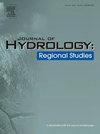What drives the distinct evolution of the Aral Sea and Lake Balkhash? Insights from a novel CD-RF-FA method
IF 4.7
2区 地球科学
Q1 WATER RESOURCES
引用次数: 0
Abstract
Study Region
The Aral Sea and Lake Balkhash.
Study Focus
This study explores the impacts of climate change and human activities on the inflow of the Aral Sea and Lake Balkhash, revealing the different driving factors behind the evolution of inland lakes in arid environments. To achieve this, we propose a novel approach that combines classical seasonal decomposition with Random Forest and Factor Analysis (CD-RF-FA) to quantitatively assess the influences of climate change and human activities on lake inflow.
New Hydrological Insights for the Region
During the period from 1960 to 1990, anthropogenic factors predominantly influenced the inflow to the lakes, contributing 89.9 %, 91.8 %, and 91.6 % to the Lake Balkhash Basin (BAK), the Syr Darya Basin (SYR), and the Amu Darya Basin (AMU), respectively. However, from 1991 to 2020, the influence of human activities diminished, and climate variables gradually dominated the changes in inflow, contributing 52.2 % and 47.2 % to BAK and SYR, respectively, with upstream inflow being the main driving factor. Additionally, reservoir construction and political factors also played significant roles in the variation of inflow, exerting direct or indirect effects. This study provides crucial insights into the complex interplay of factors affecting inland lakes in arid regions and informs strategies to mitigate the Aral Sea Syndrome.
是什么推动了咸海和巴尔喀什湖的独特演变?新型 CD-RF-FA 方法的启示
研究地区咸海和巴尔喀什湖。研究重点本研究探讨了气候变化和人类活动对咸海和巴尔喀什湖入湖量的影响,揭示了干旱环境中内陆湖演变背后的不同驱动因素。为此,我们提出了一种将经典季节分解与随机森林和因子分析(CD-RF-FA)相结合的新方法,以定量评估气候变化和人类活动对湖泊流入量的影响。对该地区水文的新认识1960 年至 1990 年期间,人为因素对湖泊流入量的影响占主导地位,分别占巴尔喀什湖流域(BAK)、锡尔河流域(SYR)和阿姆河流域(AMU)流入量的 89.9%、91.8% 和 91.6%。然而,从 1991 年到 2020 年,人类活动的影响逐渐减弱,气候变量逐渐主导了流入量的变化,对巴尔喀什湖流域和锡尔河流域的影响分别为 52.2% 和 47.2%,其中上游流入量是主要驱动因素。此外,水库建设和政治因素也在流入量变化中发挥了重要作用,产生了直接或间接的影响。这项研究为了解影响干旱地区内陆湖的各种因素之间复杂的相互作用提供了重要见解,并为缓解咸海综合症的战略提供了参考。
本文章由计算机程序翻译,如有差异,请以英文原文为准。
求助全文
约1分钟内获得全文
求助全文
来源期刊

Journal of Hydrology-Regional Studies
Earth and Planetary Sciences-Earth and Planetary Sciences (miscellaneous)
CiteScore
6.70
自引率
8.50%
发文量
284
审稿时长
60 days
期刊介绍:
Journal of Hydrology: Regional Studies publishes original research papers enhancing the science of hydrology and aiming at region-specific problems, past and future conditions, analysis, review and solutions. The journal particularly welcomes research papers that deliver new insights into region-specific hydrological processes and responses to changing conditions, as well as contributions that incorporate interdisciplinarity and translational science.
 求助内容:
求助内容: 应助结果提醒方式:
应助结果提醒方式:


